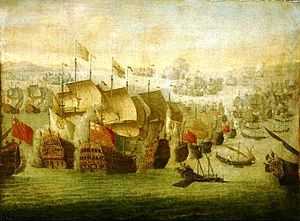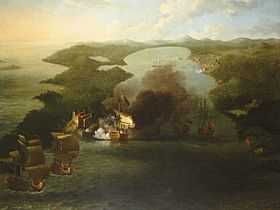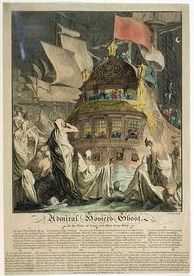Edward Vernon
| Edward Vernon | |
|---|---|
|
Admiral Edward "Old Grog" Vernon. Portrait by Thomas Gainsborough | |
| Nickname(s) | "Old Grog" |
| Born |
November 12, 1684 Westminster, London, England |
| Died |
October 30, 1757 (aged 72) Nacton, Suffolk |
| Allegiance |
|
| Service/branch |
|
| Years of service | 1700–1746 |
| Rank | Admiral |
| Commands held |
|
| Battles/wars | |
| Other work | |
Edward Vernon ("Old Grog") (12 November 1684 – 30 October 1757) was an English naval officer. Vernon was born in Westminster and went to Westminster School. He joined the Royal Navy in 1700 and was promoted to Lieutenant in 1702. After five years as Lieutenant, he was appointed Captain in 1706. His first command was the HMS Rye, part of the fleet of Admiral Sir Cloudesley Shovell.
The origin of the name "grog" for rum diluted with water and lemon or lime juice is attributed to Vernon. He innovated this way to serve the daily rum ration to Royal Navy sailors in 1740, keeping the water fresher. He was known for wearing coats made of grogram cloth, earning him the nickname of Old Grog, which in turn came to mean diluted rum. The use of citrus juice helped to avoid scurvy. Mount Vernon, the home of the first American president George Washington, was named after Vernon, since Washington's elder brother served under Edward Vernon, and gave it his name.
Early life
Born in Westminster, London, Vernon was the second son of James Vernon, secretary of state to William III. Edward had one other sibling, James who became British envoy to Denmark and served as a member of parliament and Clerk of the Privy Council. Vernon briefly attended Westminster School, then joined the Royal Navy on 10 May 1700 as a Volunteer per order on board HMS Shrewsbury. Vernon's secondary education was sharply at odds with the norm for Royal Navy officers of his day, most of whom received an elementary education before they were sent to sea at about the age of twelve.
War of the Spanish Succession
In March 1701, he was transferred to HMS Ipswich and three months later, joined HMS Mary. On 16 September 1702, Vernon was promoted Lieutenant and appointed to HMS Lennox serving in the Channel Squadron. The ship was later transferred to the Mediterranean and finally paid off in March 1704. He was then appointed to HMS Barfleur, which at the time was the flagship of Admiral Cloudesley Shovell in the Mediterranean. The ship was present at the capture of Gibraltar and the Battle of Málaga.

In December, with Shovell, he transferred to HMS Britannia and was present at the capture of Barcelona in 1705.
On 22 January 1706 he was promoted Captain and appointed to HMS Dolphin. However, he was moved ten days later into HMS Rye and remained in the Mediterranean until 1707. With the rest of Shovell’s fleet, he returned to England, but was fortunate to escape the disaster that befell Shovell’s flagship, HMS Association at the Isles of Scilly. In November, he joined HMS Jersey and in April 1708, took command of the West Indies station. In 1710, he successfully broke up a Spanish squadron off Cartagena. At the end of the War of the Spanish Succession in 1712, he returned to Britain.
Peace, promotion and parliament
In March 1715, he was appointed to HMS Assistance, in which he served in the Baltic until 1717 when the ship was paid off. After this, he was put on half pay for the next eighteen months. In March 1719, he was appointed to HMS Mary and returned to the Baltic. Vernon was the commodore of Port Royal in Jamaica in 1720. In 1721, he again went on half pay for five years. During this period, he became the member of Parliament for Penryn and took a leading part in naval debates. In 1726, he was re-appointed to active service in HMS Grafton. This ship served in the Baltic until the winter of 1727 when it was transferred to the fleet at Gibraltar, after Spain had declared war on Britain. In May 1728, peace was made with Spain and Vernon returned to Britain and resumed his Parliamentary duties. He took up the case of Robert Jenkins, a merchant seaman who claimed to have had his ear cut off after his vessel was boarded by Spanish guardacostas in 1731.
War of Jenkins' Ear
In May 1728 he took up parliamentary duties. He pursued the case of Robert Jenkins, who was alleged to have had his ear cut off by Spanish coastguards in the Caribbean. This led to the War of Jenkins' Ear in 1739 in which Vice Admiral Vernon led a fleet along with Major General Thomas Wentworth. Vernon captured Porto Bello a Spanish colonial possession, as a result of which, he was granted the Freedom of the City of London. However, Vernon's next campaign against the Spanish, a large-scale assault on Cartagena de Indias in 1741 ended in disaster. This was the biggest amphibious attack until the Invasion of Normandy in 1944:[1] in Cartagena the British fleet of 186 ships and almost 27,000 men was defeated by a garrison of 3,500 men and 6 ships of the line commanded by the one-eyed, one-armed, one-legged, Spanish admiral Blas de Lezo. The strategic defence of the colonial port of Cartagena led to heavy British casualties and eventually a retreat to Jamaica. Following the disease outbreak and quarrels with Wentworth, Vernon returned to the UK to find he had been elected MP for Ipswich.
During the War of Jenkins' Ear, Vernon was promoted Vice-Admiral (of the Blue) on 9 July 1739 and, as he had prominently spoken for both the war and the Navy, he was given the command of a squadron of six ships. The Gentleman's Magazine reported England's preparations for war against Spain in July 1739, noting that: Vernon had been recalled to active duty and promoted; that, on 10 July King George II had instructed the Lords of the Admiralty to prepare Letters of Marque; and (a week after the fact) it reported Vernon and his squadron had sailed for the West Indies on 20 July.[2]
Despite the unmistakable signs of Great Britain preparing for a naval war in the summer of 1739, the formal declaration of war against Spain was not announced in London until Saturday 23 October 1739.[3]
Porto Bello

by Samuel Scott
On 21 November 1739 Vernon captured the Spanish colonial possession of Porto Bello (now in Panama) using just six ships (against the 90 men Spanish garrison). Vernon was subsequently granted the Freedom of the City of London and commemorative medals were produced. The Portobello areas in London, Dublin and Edinburgh (see Portobello Road and Portobello, Dublin) are named after this victory, and "Rule Britannia" was composed by Thomas Arne during the celebrations in 1740. A tower commemorating his victory was erected by members of the Vernon family living at Hilton Hall outside Wolverhampton.[4]

Addressed by Hosier's Ghost
Vernon's action was seen by the "Patriots", or pro-war party opposed to Walpole, as just vengeance for Admiral Hosier's disastrous Blockade of Porto Bello during 1726-28 where with a greater force of 20 ships, and Porto Bello inadequately defended, government orders forbade him from firing a shot, leaving him and some 4,000 sailors to linger ineffectually off the shore and to die of tropical diseases. The ballad Admiral Hosier's Ghost was written by Richard Glover following Vernon's triumph, as an attempt to remind Walpole of his previous failed policy of inaction, and to check any basking in Vernon's glory on his part. In the ballad, the Ghost of Hosier appears to Vernon as he rests at anchor following his successful engagement, and congratulates him:
Unrepining at thy glory
Thy successful arms we hail.
He then charges him to let Hosier's wrongs prevail when he returns to England, upon which he and his fellow ghosts can finally rest, their reputations restored. The first half of verse 7 is thus:
For resistance I could fear none
But with twenty ships had done
What thou brave and happy Vernon
Hast atchiev'd with six alone.
Cartagena de Indias

In April 1741, with a much larger fleet and land forces under Major General Thomas Wentworth, 26,600 men and 186 ships,[5] Vernon turned his attention to Cartagena de Indias in Nueva Granada (now Colombia). Vernon was so self-confident that he sent a message to his King assuring he had conquered the city, generating a euphoria in England bigger than the capture of Portbelo produced the year before. Up to eleven types of commemorative medals were minted in London to celebrate the victory that never was. Previously he tried to bombard Cartagena with his huge squadron without success. Vernon and Wentworth did not get on and time was wasted in deciding where to land the army. When the army finally attacked at the battle of Cartagena, it was badly beaten and repelled by the garrison of less than 2,000 men and 6 ships commanded by the bravest Spanish commander, the one-eyed, one-armed and one-legged Blas de Lezo.[6] An epidemic of yellow fever, typhus, scurvy and dysentery which ravaged the crews of the ships and the soldiers ashore, compounded the problems and the force returned to Port Royal.The result, the most humiliating defeat of the Royal Navy. [7] In spite of this, the inscription in Vernon's marble memorial in Westminster Abbey credits him for the victory at Cartagena. [8]
George Washington's half-brother, Lawrence Washington, served on Vernon's flagship HMS "Princess Caroline" (an 80 gun three-decker) as a Captain of the Marines in 1741 and named his estate Mount Vernon in honour of his commander,[9] a name retained by George and until present day. At the end of May 1741, the British forces in the Caribbean decided to attack Cuba. Vernon captured Guantánamo Bay, briefly renaming it Cumberland Bay. He arrived with a force of eight warships and 4,000 soldiers with plans to march on Santiago de Cuba, but was resisted by local guerilla forces and finally abandoned the attempt in December after sickness broke out again. Vernon could no longer hold back his anger at what he perceived as Wentworth’s ineptitude and a bitter quarrel ensued ending in the recall of both parties to Britain at the end of 1742.
Further political career
While he had been away, Vernon had been elected MP for Ipswich, after having purchased the Nacton estate in Suffolk. Vernon returned to Parliament and continued to harass the government on naval affairs. In 1745, Vernon was promoted to Admiral and appointed to command the North Sea Fleet in response to the threat from the French forces in support of Charles Edward Stuart, "Bonnie Prince Charlie". This was his last operational command. When the Admiralty refused to grant him the status of Commander-in-Chief, he asked to be relieved on 1 December 1745.[10] Vernon's naval career had, however, a controversial ending. He wrote two pamphlets about his disagreements with the Admiralty. The first was entitled "A Specimen of Naked Truth from a British Sailor" and the second "Some Seasonal Advice from an Honest Sailor". As a result the Admiralty brought the matter to King George II who advised to have his name removed from the navy flag list. He was dismissed on 11 April 1746.[11]
Naval innovation and health
Throughout his career, Vernon had tried to improve naval procedures and encouraged his captains to improve manoeuvres and gun drill. He introduced new instructions to aid the flexibility of handling fleets in battle and formed the basis of continuing improvement to Admiralty fighting instructions by subsequent naval commanders.[12] Vernon continued to serve in Parliament and remained active in the interest of naval affairs until his death at Nacton on 30 October 1757.[13] Many of his proposals were subsequently adopted and contributed to Britain's victory in the Seven Years War.
His enduring claim to fame was his 1740 order that his sailors' rum should be diluted with water. In 1740, citrus juice (usually lemon or lime juice) was added to the recipe of the traditional daily ration of watered-down rum known to cut down on the water's foulness. Although they did not know the reason at the time, Admiral Edward Vernon's sailors were healthier than the rest of the navy, due to the daily doses of vitamin C the sailors received. However, it was not until 1747 that James Lind formally proved that scurvy could be treated and prevented by supplementing the diet with citrus fruit such as limes or lemons. The rest of the Royal Navy rapidly followed Vernon's lead, supposedly calling the new drink "grog" after Vernon's nickname "Old Grog", attributed to his habitual wearing of a grogram coat.[14][15] The tradition of a provision to each seaman of a tot of rum per day continued until "Black Tot Day" on 31 July 1970 when the last pipe of "Up Spirits" was heard throughout the ships and shore establishments of the Royal Navy.
Mount Vernon, the estate of George Washington, was named for the Admiral. Washington's older half-brother Lawrence Washington had served under Vernon in the War of Jenkins' Ear, and named his estate for his former commander.
Notes
- ↑ Victoria, Pablo (2005). El día que España derrotó a Inglaterra : de cómo Blas de Lezo, tuerto, manco y cojo, venció en Cartagena de Indias a la otra "Armada Invencible". Barcelona: Áltera. ISBN 84-89779-68-6.
- ↑ The Gentleman's Magazine, "Historical Chronicle: Tuesday, 31 July" Vol. 9, July 1739, pp. 383 and 384; accessed 13 May 2010.
- ↑ The Gentleman's Magazine, "Historical Chronicle" Saturday 23 October Vol. 9, October 1739, page 551; accessed 13 May 2010.
- ↑ History of Hilton Hall
- ↑ Paper presented in 2000 to LACLIO Conference at Stanford University
- ↑ Harding, Richard. Amphibious Warfare in the Eighteenth Century: The British Expedition to the West Indies, 1740-1742. Royal Historical Society: Studies in History, vol. 62. The Boydell Press. London: 1991.
- ↑ Crewe, Duncan. Yellow Jack and the Worm: British Naval Administration in the West Indies, 1739-1748. Liverpool University Press: 1993
- ↑ Admiral Vernon's memorial at Westminster Abbey
- ↑ Ranft, Brian, editor. The Vernon Papers. Naval Records Society, vol. 99. London: 1958
- ↑ Hartman, Cyril H. The Angry Admiral: The Later Career of Edward Vernon, Admiral of the White. William Heinemann Ltd. London: 1953.
- ↑ Vernon, Edward (1746). Original Letters to an Honest Sailor. London. p. 94.
- ↑ Precursors of Nelson: British Admirals of the Eighteenth Century; edited by Peter Le Fevre & Richard Harding; Stackpole Books (London: 2000); Chapter 6 "Edward Vernon" pp. 151-176
- ↑ Palmer, Michael A. Command of the Sea: Naval Command and Control since the Sixteenth Century. Harvard University Press. London:2005, pp.101-104
- ↑ Pack, James. Nelson's Blood: The Story of Naval Rum. Naval Institute Press. Annapolis:1982, chapter 1 "Old Grogram" pp.1-18.
- ↑ "Grogram". Wordsmith.org. July 15, 2014. Retrieved 15 July 2014.
References
- Harding, Richard (2008). "Vernon, Edward (1684–1757)". Oxford Dictionary of National Biography (online ed.). Oxford University Press. doi:10.1093/ref:odnb/28237. Retrieved 18 July 2010.
External links
| Wikimedia Commons has media related to Edward Vernon. |
| Parliament of Great Britain | ||
|---|---|---|
| Preceded by Viscount Rialton Samuel Trefusis |
Member of Parliament for Penryn 1722–1734 With: Sidney Meadows 1722–1727 Sir Cecil Bishopp 1727–1734 |
Succeeded by Sir Richard Mill John Clavering |
| Preceded by William Wollaston Samuel Kent |
Member of Parliament for Ipswich 1741–1757 With: Samuel Kent |
Succeeded by Thomas Staunton Samuel Kent |
|
